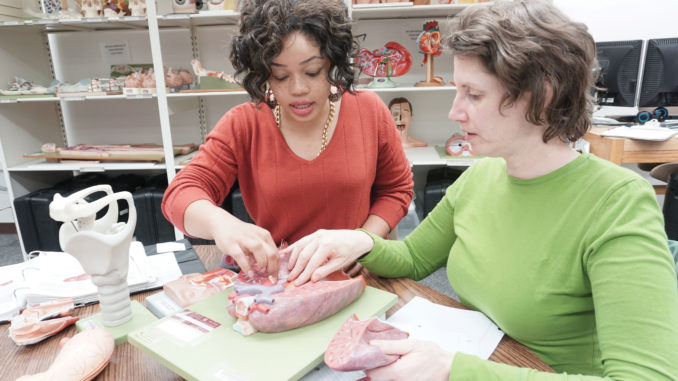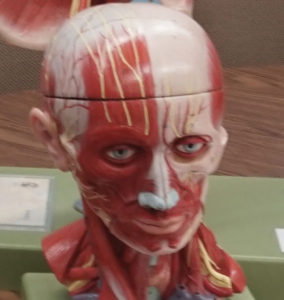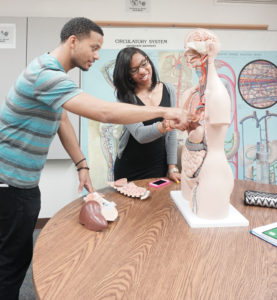
By Jasmine Hsieh
The Scene staff
Anatomy and physiology courses can be difficult, particularly if students don’t have access to models of the human body, bones, muscles, organs, glands and blood vessels.
That’s not a problem at Forest Park.
The college has a Bone Room in the lower level of the library building, complete with anatomical models, body system posters, tutoring services and Anatomy TV, an electronic resource allowing students to view and interact with 3-D images.
“The Bone Room is a great resource,” said nursing major Pablo Ramirez, 27. “We see materials printed on the textbook, and I can come here to find models to match them up and actually study where the locations are at.”
The Bone Room is open the same hours as the library. Tutoring is available from 9:30 a.m. to 5 p.m. Mondays through Thursdays and 9:30 a.m. to 1:30 p.m. Fridays on a walk-in basis.
The Bone Room is the brainchild of June Williams, senior manager of library and instructional resources. It was named Forest Park’s Innovation of the Year on Feb. 23.

“This award is recognition,” Williams said. “The Bone Room is an idea, and to see that idea doing so well and having benefited so many students is great to me.”
In the past, students in anatomy and physiology could only check out limited and sometimes outdated models in the library, and no tutoring was available.
Williams created the Bone Room in January, 2013, with help from Melissa Ingram, a former biology Supplemental Instruction leader who became its first tutor. They spent more than $15,000 of library funds for equipment.
“It took me almost two years to finish matching and purchasing all the models with what they have in the labs,” Ingram said. “So when students get out of class, they can come here and we have everything.”
Students majoring in nursing, funeral services, biology and surgical technology and those enrolled in dental programs are required to take anatomy and physiology.
Williams hired Kris Robinson to be the Bone Room’s second tutor last fall. He had started out using it as a student.
“I had a number of requests from students wanting us to expand the hours and hire more tutors, since Melissa had a heavy workload being the only tutor here,” Williams said. “Kris has also been a great tutor, and students love him.”
Ingram, 29, changed her major from nursing to biology after working in the Bone Room, which helped her discover a love of teaching.

To supplement tutoring, Ingram invites students to submit anatomy and physiology questions in a box. She displays the answers on a board, along with her own quizzes.
The Bone Room gets 100 to 300 visits from students each month, peaking at 366 in October.
“We also often have students from other campuses come here to our Bone Room to study and ask questions,” Ingram said.
The Meramec and Wildwood campuses of St. Louis Community College don’t have bone rooms.
The Florissant Valley campus has an Anatomy and Physiology Room, but it’s only a third of Forest Park’s Bone Room with no tutors.
“I can proudly say that Forest Park has the best resources,” Williams said.
Ingram and Robinson also offer online tutoring for students at Florissant Valley via Blackboard Collaborate, an interactive learning tool.
General Transfer student Daphne Lui sees a correlation between Bone Room visits and student success in anatomy and physiology.
“All the students who I had seen coming to the Bone Room in my A&P class have all moved on to A&P II,” she said. “It was those students who I never saw here that dropped out. That alone should tell you something.”
